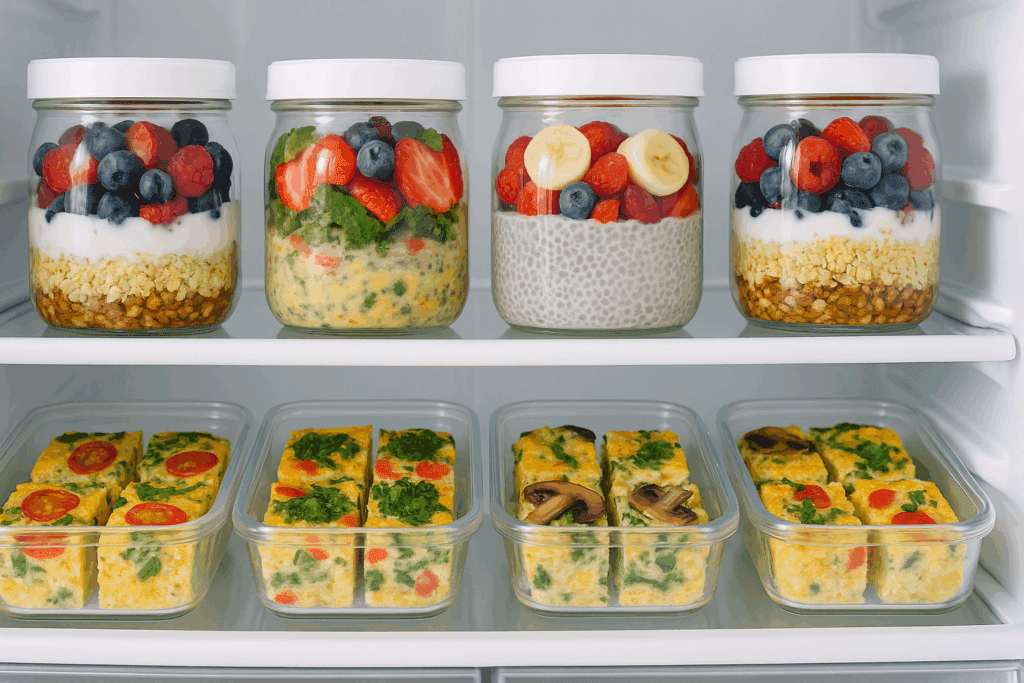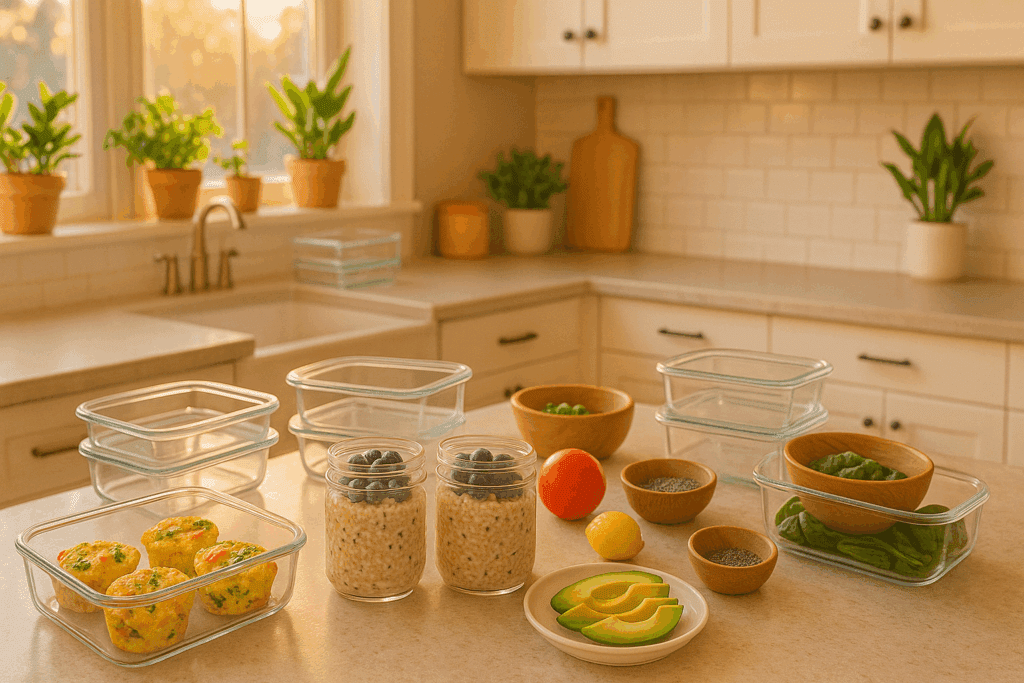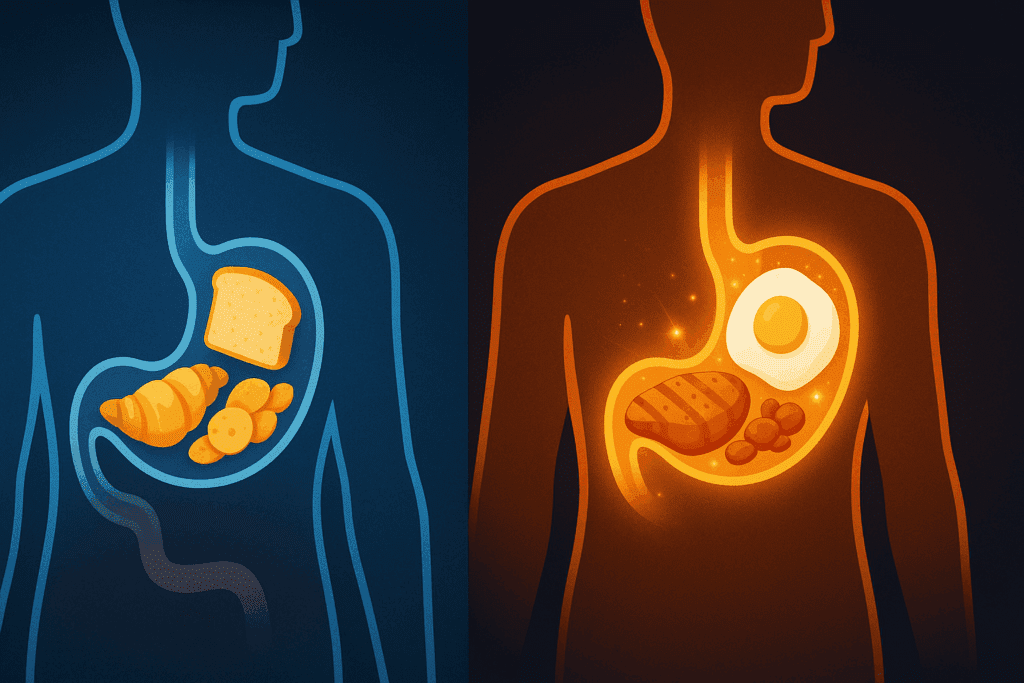For many individuals striving to maintain a balanced lifestyle, the quest for optimal energy, sustained focus, and effective appetite control begins with a deceptively simple decision: what to eat for breakfast. Amidst the fast pace of modern life, it’s tempting to grab a pastry or skip the meal entirely. However, emerging research in nutritional science and metabolic health underscores the pivotal role of a strategically crafted morning meal—particularly one that is high in protein, prepared in advance, and tailored to fuel the body and brain without compromising convenience. A thoughtfully designed high protein make ahead breakfast not only saves time but also supports metabolic health, sustains satiety, and helps prevent the mid-morning energy slump.
You may also like: Smart Meal Prep Ideas for a Low Carb Diet: Sustainable Strategies for Weight Loss and Lasting Energy
The Metabolic Power of Protein in the Morning
At the heart of the conversation about breakfast and metabolism lies protein—a macronutrient long celebrated for its role in muscle repair and immune function. However, its influence extends much further, especially when consumed early in the day. Unlike carbohydrates, which are rapidly digested and absorbed, protein takes longer to break down, thereby slowing gastric emptying and enhancing feelings of fullness. This extended satiety is a key player in reducing overall caloric intake, especially in individuals who are prone to snacking or overeating later in the day.
A meal prep protein breakfast rich in high-quality protein sources—such as eggs, Greek yogurt, cottage cheese, tofu, or lean meats—stimulates the release of satiety hormones like peptide YY (PYY) and glucagon-like peptide-1 (GLP-1), which help regulate hunger. Additionally, protein’s thermogenic effect—the energy required to digest and metabolize food—is greater than that of carbohydrates or fats. This means that consuming a protein-dense breakfast increases energy expenditure and may modestly support fat loss over time.
Moreover, protein intake in the morning has been linked with improved glycemic control. Studies have shown that a high protein make ahead breakfast helps stabilize blood sugar levels throughout the day, particularly in individuals with insulin resistance or type 2 diabetes. By minimizing postprandial glucose spikes and dips, protein sets the stage for consistent energy and fewer cravings—a foundational benefit for those aiming to optimize metabolic health.

Strategic Simplicity: The Case for Make Ahead Meals
While the metabolic benefits of protein are clear, the challenge lies in implementation. This is where the concept of a make ahead protein breakfast becomes indispensable. Meal preparation removes the guesswork from healthy eating and ensures that nutrient-dense options are readily available, even on the busiest mornings. Whether it’s a savory egg muffin packed with vegetables or a creamy chia pudding layered with nuts and seeds, make ahead options eliminate barriers to consistency and adherence.
Consistency is essential for realizing the long-term benefits of any dietary change. Without preparation, even the most well-intentioned health goals can falter in the face of time constraints, decision fatigue, or lack of access to nutritious ingredients. Preparing breakfasts in advance mitigates these challenges, empowering individuals to stay on track without sacrificing taste or satisfaction.
In addition to fostering consistency, make ahead meals support portion control. Pre-portioned servings remove the ambiguity of estimating caloric intake and help align breakfast habits with broader health goals. This is particularly valuable for individuals monitoring macronutrient intake or working toward weight management objectives. In essence, a meal prep protein breakfast is not only about the food itself but also about the structure and predictability it brings to a morning routine.

Craving Control: Curbing Appetite Through Nutrient Density
Cravings, especially for sugary or highly processed foods, are a formidable barrier to dietary success. One of the most compelling arguments for a high protein make ahead breakfast is its capacity to blunt these cravings before they start. Unlike high-carb, low-protein breakfasts that trigger a rapid rise and subsequent crash in blood glucose, protein provides a steady release of energy, reducing the urge to reach for snacks between meals.
The biological mechanisms behind this are grounded in neuroscience and endocrinology. Protein impacts dopamine pathways in the brain—systems involved in reward and motivation—helping to regulate cravings and emotional eating. By starting the day with protein, individuals may experience improved mood, sharper focus, and a greater sense of control over food choices.
From a psychological standpoint, having a nutritious, satisfying breakfast ready to go can also reduce decision fatigue and the emotional toll of morning chaos. When a meal is already prepared, the mental burden of figuring out what to eat is eliminated, allowing for a smoother, more mindful start to the day. This is especially critical for individuals with demanding schedules or those managing chronic conditions that require dietary vigilance.

The Science of Satiety: How Protein Keeps You Full Longer
Satiety—the feeling of being satisfied and full after eating—is a cornerstone of effective weight management and healthy eating patterns. Protein is the most satiating macronutrient, and its role in appetite regulation has been confirmed by numerous clinical studies. A make ahead protein breakfast helps extend satiety well into the late morning or early afternoon, reducing the likelihood of impulsive snacking or overeating at subsequent meals.
This extended satiety is particularly important in today’s environment of abundant, highly palatable, energy-dense foods. By promoting fullness and reducing the desire for hyper-processed snacks, a high protein breakfast can create a metabolic buffer that shields against overeating and energy crashes. Importantly, protein does not act in isolation. When paired with fiber-rich vegetables, whole grains, or healthy fats, its satiety-promoting effects are further amplified, making for a balanced, nutrient-dense morning meal.
Additionally, protein helps preserve lean muscle mass, which plays a crucial role in basal metabolic rate (BMR). As muscle mass increases, so too does the body’s resting energy expenditure. This creates a virtuous cycle: high protein intake supports muscle maintenance, which in turn enhances metabolic function, making it easier to manage body weight over time.
Fueling the Brain and Body for Optimal Performance
Beyond metabolic and weight-related benefits, a high protein make ahead breakfast significantly contributes to cognitive and physical performance. The brain, though it relies primarily on glucose for energy, also benefits from amino acids—the building blocks of protein—which are involved in the synthesis of neurotransmitters such as serotonin and dopamine. These chemicals influence mood, attention, memory, and motivation, all of which are essential for productivity and mental clarity.
Consuming a make ahead protein breakfast can also support physical endurance and muscle recovery, especially for individuals who exercise in the morning or follow strength training regimens. Protein intake shortly after waking helps replenish amino acid pools depleted during overnight fasting and initiates muscle protein synthesis. When incorporated into a routine, this habit can improve overall body composition and exercise outcomes.

Furthermore, the synergy between macronutrients and micronutrients in a well-designed breakfast cannot be overstated. Nutrient-dense options like spinach, avocado, oats, and nuts provide vitamins, minerals, antioxidants, and phytochemicals that work in concert with protein to optimize cellular function and reduce oxidative stress. By preparing meals in advance, individuals can ensure that their breakfast includes a diverse array of these nutrients, reinforcing the body’s ability to perform, recover, and adapt to daily demands.
Practical Approaches to Building the Perfect Make Ahead Protein Breakfast
Creating a meal prep protein breakfast that is both delicious and effective doesn’t require gourmet skills or elaborate recipes. The key lies in choosing high-quality protein sources and pairing them with ingredients that enhance texture, flavor, and nutritional value. Eggs, for instance, can be baked into muffins with sautéed vegetables, cheese, and herbs. Greek yogurt can be transformed into parfaits with berries, granola, and flaxseeds. Overnight oats, blended with protein powder, nut butter, or chia seeds, offer a portable and satisfying solution.
Batch cooking is another powerful strategy. Preparing larger quantities of breakfast burritos, frittatas, or protein pancakes and storing them in the refrigerator or freezer can ensure a steady supply of balanced meals throughout the week. Investing in reusable containers and labeling meals by date can further streamline the process and minimize food waste.
Personalization is also critical. Not everyone has the same nutritional needs or taste preferences, so a high protein make ahead breakfast should be tailored accordingly. For individuals following plant-based diets, options like tofu scrambles, lentil patties, or almond butter smoothies provide ample protein while aligning with ethical and dietary values. Including a variety of herbs and spices can elevate flavor profiles and add additional health benefits such as anti-inflammatory and antimicrobial properties.
Sustaining Long-Term Habits Through Structure and Flexibility
The most successful dietary strategies are those that blend structure with flexibility. While it’s important to establish consistent routines around breakfast, it’s equally vital to allow for variety and adaptation. A meal prep protein breakfast plan should evolve with changing seasons, personal goals, and lifestyle shifts. This prevents monotony, enhances dietary diversity, and keeps the experience enjoyable.
Scheduling weekly prep sessions, experimenting with new recipes, and involving family members or housemates in the process can transform meal preparation from a chore into a meaningful ritual. Over time, these small investments yield substantial dividends in the form of improved energy, reduced stress, and enhanced overall well-being.
Ultimately, the goal is not perfection but sustainability. By prioritizing convenience, nutrition, and enjoyment, individuals can develop a breakfast routine that is resilient, rewarding, and conducive to long-term health outcomes. The principles of mindful eating—such as tuning into hunger cues, savoring flavors, and practicing gratitude—can be seamlessly integrated into the breakfast experience, enriching both physical and emotional wellness.

Frequently Asked Questions: High Protein Make Ahead Breakfasts
1. What are some overlooked ingredients to include in a high protein make ahead breakfast?
While eggs and Greek yogurt are staples, there are several lesser-known ingredients that can elevate your high protein make ahead breakfast. For instance, hemp hearts are a nutritional powerhouse, offering a complete amino acid profile in just a few tablespoons. Additionally, silken tofu can be blended into smoothies or overnight oats to add creaminess and protein without altering flavor. Nutritional yeast not only contributes to a savory, cheesy flavor but also boosts B vitamins and protein content. These underrated options can help you diversify your breakfast routine without compromising protein density or convenience.
2. How can a meal prep protein breakfast support muscle health during aging?
As we age, maintaining muscle mass becomes increasingly important due to the natural process of sarcopenia, or age-related muscle loss. A meal prep protein breakfast offers a consistent way to deliver high-quality protein during the critical post-overnight fast, which is especially helpful in older adults. Incorporating leucine-rich foods like dairy, poultry, or soy enhances muscle protein synthesis, helping preserve lean mass and functional strength. Planning ahead ensures older adults meet their daily protein goals without skipping meals. This proactive strategy supports longevity, mobility, and independence well into later life.
3. Can a make ahead protein breakfast help with cognitive performance at work or school?
Absolutely. Starting your day with a make ahead protein breakfast can enhance mental alertness, memory retention, and focus. Unlike carbohydrate-heavy breakfasts, which can lead to blood sugar spikes and subsequent crashes, protein-rich options offer more stable energy and improved neurotransmitter function. Amino acids like tyrosine and tryptophan found in protein support dopamine and serotonin production, which influence mood and cognitive clarity. By reducing distractions from hunger and improving satiety, this kind of breakfast creates the perfect foundation for a productive day.
4. How do cultural and dietary preferences affect the design of a high protein make ahead breakfast?
Cultural traditions and dietary philosophies greatly influence breakfast choices, but they can easily accommodate a high protein make ahead breakfast approach. For example, in Japanese cuisine, make ahead dishes like tamagoyaki (rolled omelet) and natto (fermented soybeans) are both protein-rich and culturally resonant. In plant-based diets, options such as lentil pancakes or chickpea flour muffins can be prepared ahead and adapted with herbs and spices for variety. Recognizing the importance of cultural food identity while enhancing protein content empowers individuals to maintain both authenticity and nutritional balance. It also increases the likelihood of long-term habit formation through enjoyment and familiarity.
5. What are common mistakes to avoid when creating a meal prep protein breakfast? One
frequent pitfall is relying too heavily on processed protein powders while neglecting whole food sources. While protein powders can be convenient, they often lack the fiber, phytonutrients, and digestive support found in real foods. Another mistake is failing to balance macronutrients—some may focus on protein alone without including healthy fats and complex carbohydrates, which support sustained energy. Additionally, not varying ingredients can lead to flavor fatigue, which undermines consistency. Thoughtfully curating your meal prep protein breakfast each week with different textures and nutrient sources can keep it satisfying and sustainable.
6. How can families implement a make ahead protein breakfast routine with kids?
Introducing a make ahead protein breakfast into a family routine can be both fun and educational. Involving children in the prep process—from choosing recipes to assembling ingredients—helps build their confidence and fosters healthier relationships with food. Kid-friendly protein options like mini egg muffins, yogurt parfaits with nut butter, or banana oat protein pancakes can be tailored to young taste buds. Using visually appealing containers or adding colorful fruit can also make these breakfasts more enticing. The result is not only a nutritious start to the day but also a powerful opportunity to instill lifelong healthy habits.
7. Are there environmental benefits to preparing high protein breakfasts in advance?
Yes, there are significant sustainability advantages to adopting a high protein make ahead breakfast routine. Bulk preparation often reduces food waste by enabling more efficient use of ingredients and leftovers. Choosing plant-based protein sources such as legumes, seeds, and tofu—especially when prepping in advance—also reduces the carbon footprint associated with animal products. Additionally, using reusable storage containers and minimizing single-use packaging further supports an eco-friendly approach. By aligning dietary habits with environmental responsibility, individuals can make a broader impact through small, daily choices.
8. Can athletes or highly active individuals benefit from a meal prep protein breakfast?
Athletes and fitness enthusiasts have heightened protein needs, particularly around training sessions. A well-planned meal prep protein breakfast can jumpstart recovery by replenishing amino acids and stabilizing energy levels. Including fast-digesting proteins like whey or pairing carbs with protein-rich foods (e.g., overnight oats with collagen peptides) can optimize performance and muscle repair. For those with early workouts, a portable pre-prepared breakfast ensures they refuel promptly, which is critical for recovery windows. Strategically designed breakfasts support endurance, reduce fatigue, and promote better body composition over time.
9. What innovations or trends are emerging in the world of make ahead protein breakfasts?
The functional food market is increasingly embracing innovation in the form of portable, protein-rich breakfast options. Products like high-protein overnight oats in single-serve jars, savory breakfast bars with egg whites, and drinkable breakfast smoothies fortified with micronutrients are gaining popularity. Fermented high-protein items—such as miso-infused tofu or kefir blended with chia—are also on the rise for their gut health benefits. As technology and nutrition science converge, expect to see more smart appliances and apps dedicated to streamlining the make ahead protein breakfast process. These advancements promise to reduce prep time while enhancing nutrition and personalization.
10. How can someone transition from sugary breakfasts to a high protein make ahead breakfast without feeling deprived?
Transitioning from sugar-laden cereals or pastries to a high protein make ahead breakfast doesn’t have to feel restrictive. Start by incorporating naturally sweet but protein-rich foods like Greek yogurt with berries or almond butter spread on whole-grain toast. Spices like cinnamon and vanilla can add warmth and sweetness without added sugar. Gradually increasing protein and fiber content while reducing simple sugars allows taste preferences to shift over time. Focusing on satiety and flavor satisfaction helps reinforce positive associations, making the transition feel more like a delicious upgrade than a dietary sacrifice.

Conclusion: A Nourishing Path Forward with a Make Ahead Protein Breakfast
In a world where demands on time, energy, and attention are at an all-time high, the simple act of preparing a high protein make ahead breakfast represents a powerful form of self-care and intentional living. It is a practice rooted in science, sustained by habit, and elevated by creativity. From stabilizing blood sugar to enhancing focus, from curbing cravings to supporting long-term metabolic health, the benefits of this approach are far-reaching and well-substantiated.
Whether you’re managing a busy career, pursuing fitness goals, or simply striving for more balanced energy throughout the day, investing in a meal prep protein breakfast is a strategic choice that pays dividends across every aspect of life. With thoughtful planning, even the most hectic mornings can begin with nourishment, satisfaction, and a sense of empowerment.
By embracing the principles of mindful eating, prioritizing protein-rich foods, and preparing meals in advance, anyone can create a morning ritual that fosters resilience, clarity, and well-being. A high protein make ahead breakfast is more than just a dietary tactic—it’s a daily commitment to thriving, from the inside out.
Further Reading:
good high protein breakfasts??
Make a Week of Cheap, Easy, High-Protein Breakfasts in Less Than an Hour

